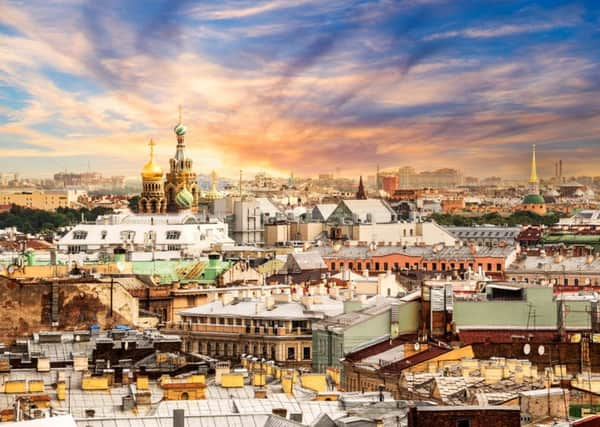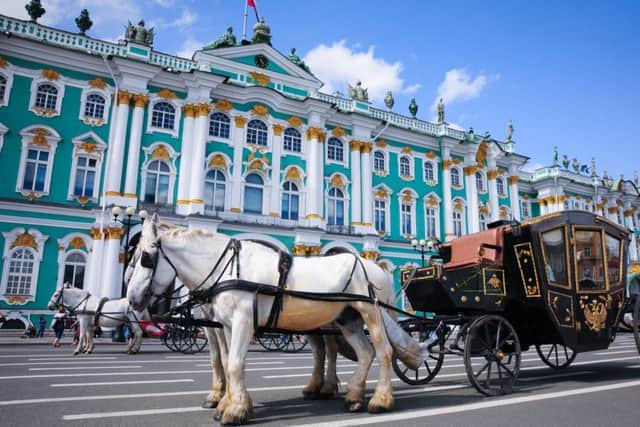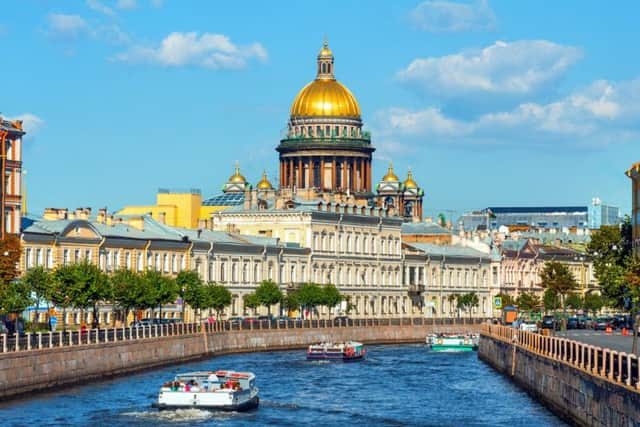St Petersburg, Russia: Travel, Scotland on Sunday


The city of St Petersburg has been on my radar for some time. Intrigued by Russia, following this summer’s football World Cup I took the plunge and signed up for a trip to one of its most alluring destinations.
Russia is a topical and controversial subject right now, but I decided not to let that get in the way of my wanderlust. I knew St Petersburg had plenty of history and I wanted to experience a completely different city break.
Advertisement
Hide AdAdvertisement
Hide AdThe first part of my St Petersburg plan was working out how to get there. Dutch airline KLM wins hands down, flying up to four times a day to Amsterdam Schipol from Scotland and connecting nicely with the afternoon flight to Pulkovo Airport. There are options from Edinburgh, Glasgow, Aberdeen and Inverness.


With the flights sorted, it was time to tackle the visa. The forms are comprehensive, but the process is straightforward, taking five days in total. You need an “invitation” to support your application, but that can be provided by the Russian National Tourism Office. They are helpful and can also give assistance on tours. Buoyed by the promise of an unforgettable experience, I set off for St Petersburg armed with my documents and a sense of excitement.
I stayed at the Corinthia Hotel, located in an 18th-century building on St Petersburg’s principal street, Nevsky Prospect. The city has lots of accommodation to suit all budgets, but the Corinthia is right in the heart of it and offers a touch of luxury. I stayed in one of its executive club rooms for my three nights. The hotel has a traditional, stately yet homely feel about it. Staff were impeccable and it has won awards for its recent renovation. I also discovered that Brazil stayed here during the World Cup. That’s good enough for me – even if Neymar slept in my bed!
After a excellent meal at the hotel’s Imperial Restaurant, I took an evening stroll down Nevsky Prospect. It’s a bustling thoroughfare lined with suave, commanding structures. I went to bed looking forward to seeing everything in daylight.
I was not let down. Budget-permitting, it’s worth investing in a guide as the city is peppered with history. St Petersburg – or Leningrad, as it was known to the Soviets – was besieged by the Nazis for 872 days during the Second World War. Despite the front line being only seven kilometres from the city centre, Leningrad held out and most of its buildings were unscathed – but at a terrible cost of one million lives.


St Petersburg is 315 years old and was founded by Peter the Great, hence why it was also known as Petrograd before taking its current name. It was constructed to be a cultural epicentre rather than industry-led. Not far from the Baltic Sea, the Neva river scythes through the city with numerous canals splintering from it. The city spans 47 islands and has 350 bridges. The architecture is not what I expected from an ex-Soviet city. St Petersburg has a subtle west-European influence and the buildings are in hues of soft yellows, greens and pinks. All very easy on the eye, and with laws about how high everything can be, it is in stark contrast to other big cities. St Petersburg has a population of five million – not that you feel it.
Culturally, St Petersburg has a couple of thoroughbreds in its stable. The Hermitage and Winter Palace is the city’s landmark attraction. The palace – once the home of Catherine the Great – has been converted into a vast museum that will keep you occupied for a day. It’s a celebration of art across the world rather than local exhibits and houses works by the likes of Rembrandt, Da Vinci and various other old masters, as well as more modern paintings by Chagall and Picasso.
France has clearly had an impact on St Petersburg. St Isaac’s is the fourth biggest cathedral in the world and was designed by French architect Auguste de Montferrand. When I entered, I felt like I had walked inside a Fabergé egg. The decoration is lavish, with mosaics, frescos and golden statues. The cathedral also has a colonnade which is well worth scaling the 262 steps to get to. Because of the aforementioned height restrictions in St Petersburg, vistas from on high are at a premium. This is one well worth making the effort to enjoy.
Advertisement
Hide AdAdvertisement
Hide AdSt Isaac’s does not look typically Russian, but the Church of the Saviour on Spilled Blood does. Adorned with a couple of traditional cupolas, it looks more what I expect Moscow’s Kremlin to be like and is a reminder that you are in Russia. So much of St Petersburg is not what I envisaged: beautiful buildings and genuinely friendly people in a city that gently permeates class.
The food is of a high standard and I had a couple of gourmet meals, one of which was a lunch at Percorso, the Four Seasons Hotel’s Italian restaurant. Mansarda, located next to St Isaac’s, is another fine establishment with a Russian-Asian vibe, but you can also eat heartily for modest sums. My personal recommendation would be the restaurant within the Russian Vodka Museum, which specialises in local fare. Russian cuisine is better than its reputation, with beef stroganoff and Kamchatka crab my favourites. It’s all best washed down with vodka, straight rather than mixed. The Russians don’t mess with their booze.
With so much of the city surrounded by water, river cruises are plentiful. Viewing it from a different perspective and drinking in the chic surroundings left me feeling relaxed and enriched.
The pièce de résistance of my trip, however, was taking in a ballet performance of Cinderella. I had never been to the ballet before and admit that I am not a regular theatre goer. This, however, took my breath away. Mikhailovsky Theatre was delightfully appointed in true Russian style, with spectators dressed to the nines. The show was spectacular. The dancers were so talented, graceful and not once out of sync with the music. Shouts of “Bravo!” could be heard throughout and as I stood to applause rapturously, I couldn’t help feeling genuinely spoiled by what I had just witnessed.
Russia is not on the radar of most travellers. There is an unease about going there, but I feel preconceptions are unfounded. With a mix of history, culture, warmth and quality, I recommend that you throw your inhibitions aside and embrace St Petersburg. Not for some time have I visited a destination and come away feeling so spellbound by it.
• KLM flies to St Petersburg from Edinburgh, Glasgow, Aberdeen and Inverness via Amsterdam. KLM operates two daily flights between Amsterdam and St Petersburg in summer and a daily flight in winter. Return economy fares from Edinburgh airport start from £197 including taxes and charges. Passengers can book online at www.klm.co.uk or by calling reservations 0207 660 0293.
• Corinthia Hotel, Nevsky prospect, 57, St Petersburg, Russia 191025, (+7 (812) 380 20 01, www.corinthia.com/en/hotels/stpetersburg). Rates for an executive room with full access to the executive lounge start from RUB14,500 (£166) a night with breakfast.
• Russian National Tourist Office, 202 Kensington Church Street, London, W8 4DP 0207 985 1234, www.visitrussia.org.uk, operates as a destination management company and specialises in individual and group tours. They also assist with applying for visas with document pre-checks and the fingerprints submission.